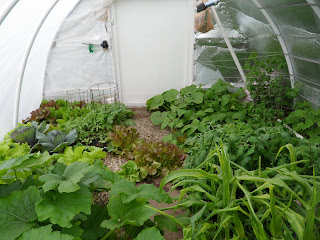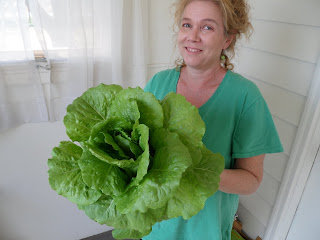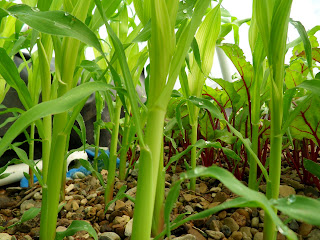1) Allows for economical year-round food production.
The water in the system serves as a large thermal mass that traps heat
during the day and keeps the environment warm enough during winter
nights to support continuous growing.
2) Drastically reduces pollution of crops.
First, it keeps contaminated rainwater off of them. Second, it gives
us the opportunity to clean the internal environment up a bit for them.
If we pull outside air through a filtration system and blow this clean
air into the tunnel, then unwanted pollution would have a hard time
seeping in, as any possible path in would be filled with clean air
rushing out. If we complement the clean air with clean water pulled up
from a deep well, we would have a pollution-free environment in which to
grow our food. Pollination would then pose a problem, but if we make
the buildings large enough to host small bee hives (or provide insulated
tube pathways between smaller tunnels for them), we'd get fantastic
pollination...and a tasty crop of honey.
3) Allows for massive localization of food production. Not only will produce be fresher, this allows consumers to have access to superior-tasting
varieties
of produce that aren't carried in our grocery stores because they don't
ship well. On a community level, localized food production leads to
other major benefits as well, such as enhanced local employment and all
the positives that go along with that. It should also be noted that
this would have a significant effect on social stability: our current
food distribution system leaves our society susceptible to calamity
(starvation and massive unrest) if shipping were to break down, whereas
large-scale localized food production would make our society much more
robust and capable of enduring much harsher conditions without
disintegrating.
4) The need for supplemental irrigation is eliminated. The plants are already constantly and automatically irrigated.
5) The need for weed control is eliminated. Since
crops are predominantly grown in gravel, clay balls, or just water, the
systems are initially weed free. And since the high tunnel keeps weed
seeds from blowing in, the systems stay weed free.
6) Pest problems are greatly reduced. The high tunnel keeps bugs and vermin out (especially with the help of an electric fence).
7) Allows our food system to be far less dependent on fossil fuels.
The amount of fossil fuels used for shipping food would be drastically
reduced (no longer shipping hundreds/thousands of miles), as would the
amount of fossil fuels used to fertilize the crops (no longer needing to
use as much natural gas to make nitrogen fertilizer, since fish waste
would supply more than enough nitrogen fertilizer).
8) Wind damage of crops is greatly reduced.
The tunnel provides a sanctuary against the destructive force of winds, thereby allowing faster and lusher growth.
9) Water is conserved to an extreme degree.
Recirculating aquaponics is often said to use about 95% less water
than traditional irrigation farming. And by placing an aquaponics
system in a high tunnel, I'm guessing that of that 5% that manages to
enter the air through transpiration and evaporation, something like 95%
of it is captured and reused in the winter when the tunnel is buttoned
up fairly tight (the water condenses on the leaves and plastic film,
then drips back down into the system). This means that a high tunnel
aquaponics system can retain and recycle something on the order of
99.75% of its water during cool/cold weather. This number would be
lower in warm weather, as more of the airborne water would be able to
escape due to increased temps and increased ventilation, but water
retention would still be impressively high.
10) Allows for enormous growth of inland fish/seafood production, which is immensely important since
virtually all of the oceans' natural fish stocks are facing catastrophic collapse.
11)
Allows families to provide the type of diet for themselves that many
people suffering from Type 2 diabetes would require if meds were
unavailable. (Discussed in another post
here.)
12) Allows families to have a large supply of fresh water on hand for emergency use.
It's true that a good high tunnel aquaponics system can generate
enormous amounts of food, but since the human need for water is even
more urgent than the need for food, it's nice that these systems double
as massive stores of fresh water.
13) The system is ideal for organic food production. Since harsh fertilizers/pesticides/etc would hurt the
fish, gentler organic methods are naturally preferred.
14) Provides a soothing and therapeutic sanctuary.
It's tough to convey just how much pleasure I derive from my own high tunnel aquaponics
system as a place to relax, think, and enjoy nature. I wish everyone
could have such a place for themselves.




















































